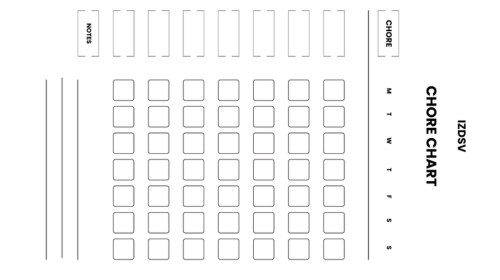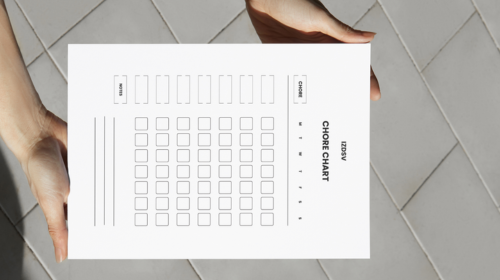Organize Your Home with a Magnetic Color-Coded Chore Chart for Refrigerator
Benefits of Using a Magnetic Chore Chart
Magnetic chore charts offer a visual and interactive way to organize household responsibilities while keeping everyone accountable. They create a centralized system that makes chore management more engaging and less likely to be forgotten or ignored.
- Visual motivation: Children can see their progress at a glance, which encourages completion and builds a sense of accomplishment
- Flexibility: Easy to rearrange chores, add new tasks, or modify assignments based on changing family needs
- Durability: Magnetic surfaces withstand daily use better than paper charts, which can tear or get damaged
- Reusability: No need to constantly replace charts or buy new materials, making it cost-effective long-term
- Organization: Keeps all chore information in one central, visible location that the whole family can reference
- Positive reinforcement: Creates opportunities for praise and recognition when tasks are completed
- Independence building: Helps children take ownership of responsibilities without constant parental reminders
Easy to Use and Erase
Most magnetic chore charts are designed with user-friendly features that make daily updates simple and mess-free. The ability to quickly modify or reset the chart keeps the system fresh and adaptable to your family’s evolving needs.
- Dry erase compatibility: Many magnetic charts work with dry-erase markers that wipe clean easily with a cloth or eraser
- Magnetic pieces: Some use movable magnetic tiles or tokens that simply slide from “to do” to “done” sections
- No permanent marks: Unlike permanent markers or pen-based systems, changes can be made without damaging the chart
- Quick updates: Takes just seconds to mark tasks complete or reassign chores for the week
- Child-friendly: Even young children can successfully use magnetic pieces or dry-erase markers
- Mistake forgiveness: Errors can be corrected immediately without starting over or crossing things out
- Weekly reset: Simple to clear and restart for each new week or time period
Color-Coding for Multiple Kids
Color-coding transforms a potentially confusing multi-child system into an organized, clear structure that eliminates arguments about whose turn it is. Each child gets their own designated color, making it instantly obvious which tasks belong to whom.
- Individual accountability: Each child can immediately identify their specific responsibilities without confusion
- Reduced conflicts: Eliminates disputes about task ownership since colors clearly designate assignments
- Easy tracking: Parents can quickly assess each child’s completion rate by looking at their designated color
- Age-appropriate distribution: Different colors can represent different difficulty levels or time commitments suitable for each child’s age
- Rotation simplicity: Easy to rotate chores between children by simply switching color assignments
- Personal ownership: Children develop a stronger attachment to “their” colored tasks, increasing completion rates
- Visual appeal: Makes the chart more engaging and less intimidating, especially for younger children
- Customization: Can incorporate each child’s favorite color to increase their enthusiasm for participation
How to Create Your Own Magnetic Dry Erase Chore Chart
Creating a custom magnetic chore chart allows you to tailor the design specifically to your family’s needs and preferences. This DIY approach is often more cost-effective than purchasing pre-made charts and gives you complete control over size, layout, and functionality.
- Cost savings: Making your own chart costs significantly less than buying commercial versions
- Custom sizing: Design the chart to fit your specific fridge or magnetic surface perfectly
- Personalization: Include your family’s names, specific chores, and preferred color schemes
- Flexibility: Add or modify sections as your family’s needs change over time
- Creative involvement: Children can help design and decorate their own chore chart
- Quality control: Choose materials that match your durability and aesthetic preferences
- Skill building: Learn basic crafting skills while creating something functional for your home
- Satisfaction: Enjoy the pride that comes from using something you made yourself
Materials Needed for Your Chore Board
Gathering the right materials upfront ensures your project goes smoothly and results in a professional-looking finished product. Most of these supplies can be found at craft stores, office supply shops, or online retailers.
- Magnetic whiteboard or sheet: The foundation of your chart – choose a size that fits your available space
- Dry erase markers: Multiple colors for different family members or task categories
- Magnetic strips or dots: For creating movable sections or attaching pieces securely
- Ruler and pencil: For measuring and marking straight lines before permanent application
- Permanent markers: For creating labels and headers that won’t accidentally get erased
- Colored tape or washi tape: To create visual divisions and add decorative elements
- Laminator and laminating sheets: To protect printed elements and make them wipeable
- Scissors: For cutting tape, paper elements, and magnetic strips to size
- Computer and printer: For creating professional-looking labels and headers
Step-by-Step Guide to Assembling Your Chore Chart for the Fridge
Planning your layout before assembly prevents mistakes and ensures optimal functionality for your family’s daily use. Take time to measure your fridge space and sketch your design before making any permanent marks.
- Measure your space: Determine the maximum size your chart can be while still fitting comfortably on your fridge
- Design the layout: Sketch your chart on paper, including sections for names, days, chores, and completion tracking
- Create column headers: Use a permanent marker or printed labels to mark “Name,” “Monday,” “Tuesday,” etc.
- Add row divisions: Use colored tape or draw lines to separate each family member’s section clearly
- Install magnetic elements: Attach magnetic strips or dots where you’ll need moveable pieces
- Test dry-erase functionality: Ensure markers write smoothly and erase completely from all surfaces
- Add decorative touches: Include motivational phrases, stickers, or designs that appeal to your family
- Create storage solution: Designate a spot for markers and erasers, possibly with magnetic holders
- Mount and test: Place the chart on your fridge and do a trial run to ensure everything works properly
Tips for Effectively Using Your Dry Erase Chore Chart
Consistency and clear communication are the keys to making your chore chart a successful long-term tool for family organization. The chart is only as effective as the habits and systems you build around using it regularly.
- Establish a daily check-in time: Set a specific time each day when everyone reviews and updates their progress together
- Make completion rewarding: Celebrate when tasks are finished with praise, stickers, or small incentives to maintain motivation
- Keep markers accessible: Store dry erase markers in a magnetic holder directly on or near the chart for easy access
- Review and adjust regularly: Weekly family meetings to discuss what’s working and what needs to be changed
- Lead by example: Parents should also track their tasks on the chart to model good behavior
- Be flexible with modifications: Allow children to suggest changes or improvements to make the system work better
- Clear consequences: Establish what happens when chores aren’t completed, and follow through consistently
- Age-appropriate expectations: Ensure tasks match each child’s developmental level and abilities
- Positive reinforcement focus: Emphasize completed tasks more than missed ones to maintain enthusiasm
Incorporating Weekly Planning into Your Routine
Weekly planning sessions transform your chore chart from a static list into a dynamic family management tool. These regular meetings help everyone stay aligned on expectations and allow for adjustments based on changing schedules or priorities.
- Sunday planning sessions: Hold a 15-20 minute family meeting each Sunday to plan the upcoming week’s responsibilities
- Distribute tasks fairly: Rotate chores weekly so no one gets stuck with the same undesirable tasks repeatedly
- Consider the family calendar: Account for school events, appointments, and activities when assigning time-sensitive chores
- Set weekly goals: Establish family or individual targets for chore completion rates to encourage improvement
- Plan seasonal tasks: Include periodic deep cleaning, yard work, or seasonal maintenance in your weekly rotation
- Adjust for absences: Redistribute tasks when family members will be away for vacations or overnight stays
- Review the previous week: Discuss what worked well and what challenges arose to improve future planning
- Include children in decisions: Let kids have input on which chores they prefer or when they’d like to complete them
- Prepare for busy weeks: Front-load easier chores during school exam periods or busy activity schedules
Using Wet-Erase Markers for Longevity
Wet-erase markers offer superior permanence compared to dry-erase markers while still allowing for updates when needed. This hybrid approach works particularly well for elements of your chore chart that change infrequently but need occasional modifications.
- Semi-permanent headers: Use wet-erase markers for family names, days of the week, and category labels that rarely change
- Reduced ghosting: Wet-erase markers leave less residual marking than dry-erase markers after extended use
- Intentional changes only: The extra effort required to erase wet-erase marks prevents accidental deletions
- Cleaner appearance: Less smudging and accidental erasing keeps your chart looking neat and professional longer
- Combination approach: Use wet-erase for permanent elements and dry-erase for daily check-offs and variable content
- Special cleaning required: Keep an appropriate wet-erase cleaning solution or a damp cloth handy for making changes
- Color coordination: Available in multiple colors for maintaining your family’s color-coding system
- Durability benefits: Charts using wet-erase markers maintain their appearance longer with heavy daily use
- Cost consideration: While initially more expensive, wet-erase markers can reduce long-term replacement costs by preserving chart quality
Transform Your Refrigerator into a Chore Management Hub
The refrigerator serves as the natural command center of most homes since family members visit it multiple times daily. Converting this high-traffic area into an organized chore management system maximizes visibility and engagement while keeping everything centrally located.
- Prime real estate location: Everyone passes by the fridge regularly, ensuring maximum exposure to chore assignments and progress
- Magnetic surface advantage: Most refrigerators provide ample magnetic surface area for charts, holders, and organizational tools
- Central family gathering point: The kitchen area where the fridge is located naturally becomes the family communication hub
- Always accessible: Unlike charts in bedrooms or offices, the fridge location ensures 24/7 availability for updates
- Multi-purpose efficiency: Combine chore tracking with meal planning, calendars, and family announcements in one location
- Visual accountability: Public placement means everyone can see each other’s progress, encouraging completion through peer motivation
- Easy integration: Fits seamlessly into existing kitchen routines without requiring new habits or locations
- Space optimization: Utilizes vertical space that might otherwise display outdated school papers or random magnets
- Weather-resistant: Indoor location protects charts and materials from outdoor elements that might damage garage or porch displays
- Adult supervision friendly: Parents can monitor and update the system while cooking, cleaning, or spending time in the kitchen
- Guest visibility: Visitors can see your family’s organization system, potentially inspiring them to implement similar solutions
- Emergency backup: Critical household information remains accessible even during power outages or technology failures




